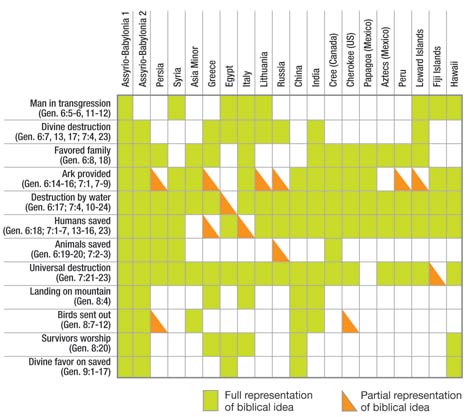Flood Legends: The Significance of a World of Stories Based on Truth by A.
J. Monty White, Ph.D.
There are hundreds of stories and legends about a
worldwide flood. Why do diverse cultures share a strikingly similar story?
Did you know that stories about a worldwide flood are found in historic
records all over the world? According to Dr. Duane Gish in his popular book
Dinosaurs by Design,
there are more than 270 such stories, most of which share a common theme and
similar characters. So many flood stories with such similarities surely come
from the Flood of Noah’s day.
A Historical Event
The worldwide catastrophic Flood, recorded in the book of Genesis, was a real
event that affected real people. In fact, those people carried the knowledge of
this event with them when they spread to the ends of the earth.
The Bible declares that the
earth-covering cataclysm of Noah’s day is an obvious fact of history. People
“willingly are ignorant [that] ... the world that then
was, being overflowed with water, perished” (2
Peter 3:5–6, KJV). This Flood left many evidences, from the fact that over
70% of the rocks on continents were laid down by water and
contain fossils, to the widespread flood legends. Both of these evidences
provide compelling support for this historical event.
If only eight people—Noah’s family—survived the Flood, we would expect there
to be historical evidence of a worldwide flood. If you think about it, the
evidence would be historical records in the nations of the world, and this is
what we have, as the chart [below] indicates. Stories of the Flood—distorted
though they may be—exist in practically all nations, from ancient Babylon
onward. This evidence must not be lightly dismissed. If there never was a
worldwide Flood, then why are there so many stories about it?
From Generation to Generation
The reason for these flood stories is not difficult to understand. When we
turn to the history book of the universe, the Bible, we learn that Noah’s
descendants stayed together for approximately 100 years, until God confused
their languages at Babel (Genesis
11:1–9). As these people moved away from Babel, their descendants
formed nations based primarily on the languages they shared in common. Through
those languages, the story of the Flood was shared, until it became embedded in
their cultural history.
Similar Stories
Hawaiians have a flood story that tells of a time when, long after the death
of the first man, the world became a wicked, terrible place. Only one good man
was left, and his name was Nu-u. He made a great canoe with a house on it and
filled it with animals. In this story, the waters came up over all the earth and
killed all the people; only Nu-u and his family were saved.
Another flood story is from China. It records that Fuhi, his wife, three
sons, and three daughters escaped a great flood and were the only people alive
on earth. After the great flood, they repopulated the world.
As the story of the Flood was verbally passed from one generation to the
next, some aspects would have been lost or altered. And this is what has
happened, as we can see from the chart. However, as seen in the given examples,
each story shares remarkable similarities to the account of Noah in the Bible.
This is true even in some of the details, such as the name Nu-u in the Hawaiian
flood story. “Nu-u” is very similar to “Noah.”
What These Stories Mean
God clearly sent a worldwide Flood to punish humankind for their evil and
corrupt ways (Genesis
6:5,
11). Even though Flood-affirming evidence from geology and other
areas of study is abundant, we don’t need this evidence to know what happened.
Starting with the Bible and the history that God faithfully recorded there,
Christians have a tool to interpret the evidence that evolutionists and
non-Christians do not. We have the record of what happened, from the One who was
there.
Global flood traditions
Dr. Duane Gish, in Dinosaurs by Design, says there
are more than 270 stories from different cultures around the world about a
devastating flood. This chart shows the similarities that several myths have
with the Genesis account of Noah’s Flood. Although there are varying degrees
of accuracy, these legends and stories all contain similarities to aspects
of the same historical event—Noah’s Flood.

Chart adapted from B.C. Nelson, The Deluge Story in Stone,
Appendix 11, Flood Traditions, Figure 38, Augsburg, Minneapolis, 1931.
Visit
Get
Answers: Noah’s Flood to read more accounts of the Flood from around the
world.
Dr. Monty White earned his B.Sc. degree in
chemistry and his Ph.D. in gas kinetics from the University of Wales,
Aberystwyth. Dr. White is now the CEO of Answers in Genesis-UK/Europe and
has traveled extensively throughout Europe lecturing on creationists’ views
of origins. http://www.answersingenesis.org/articles/am/v2/n2/flood-legends
